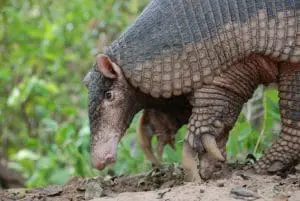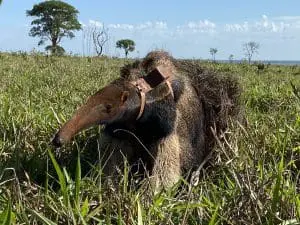

ICAS – Wild Animal Conservation Institute works to help giant anteaters and giant armadillos in Brazil. (Photo by Alessandra Bertassoni for the ICAS – Wild Animal Conservation Institute)
By visiting Brevard Zoo, YOU make an incredible impact on our natural world! Did you know that 25 cents of every daily admission and $5 of every membership goes toward our Quarters for Conservation program, which funds conservation projects throughout the world? In this “Updates from the Field” series, we’re sharing more on the projects YOU have funded!
Today, we’re learning more about one of our 2023 recipients, ICAS – Wild Animal Conservation Institute. We asked Audrey Brisseau of ICAS about their organization in this Q&A below:
When and how did your organization begin?

A giant armadillo in Brazil’s Pantanal. ©ICAS
The ICAS – Wild Animal Conservation Institute – is a Brazilian NGO dedicated to promoting harmonious coexistence between humans and wildlife in Brazil, focusing on two South American giants: The giant armadillo and the giant anteater, two species threatened of extinction.
It all began in 2010, when our founder, Zoologist Arnaud Desbiez, placed some camera traps in the Brazilian Pantanal (the largest flooded plain in the world!) to find the rare giant armadillo. That first image changed his life and the “Giant Armadillo Project,” a conservation program aiming at studying and protecting this elusive species from extinction, was founded. Soon, however, we realized we needed a legal entity for financial and administrative management of the project.
In 2017, a second project, the “Anteaters & Highways Project” was born. Originally created to quantify the impacts of roads on the giant anteater – one the main threats to the species’ survival – the project is now focusing on the human, political and institutional dimensions of wildlife collisions. We are hoping that the project will reduce the number collisions with fauna by engaging authorities, road users, highway workers and society at large. Our aim is to make roads safe for all.
Within 10 years, ICAS grew from one passionate conservationist to a multidisciplinary team (20 full-time staff, 25 volunteers/students and over 45 collaborators) and has implemented conservation actions in three of the most important biomes of the country: the Cerrado – the “Brazilian Savanna”, the Pantanal and the Atlantic Rainforest!
We were really surprised at the statistics ICAS found for Phase 1 of your Roadways Project, especially that these collisions were one of the main threats to the species in Mato Grosso do Sul. What was the public’s reaction to these numbers? Your staff’s thoughts?
Indeed, our findings indicated that the impact of the highways has cut the growth rate of the anteater population in half, which could speed up its demise.
Quite frankly, we knew the results weren’t going to be good, but we never thought it would be that dramatic. And while most people know about collisions with fauna, they don’t know how much this impacts our biodiversity. Some specific species are indeed more affected by collisions, like giant anteaters for example due to their poor vision, poor hearing, slow movements but large home ranges.
It is not a one-sided problem though. Those collisions also cause significant injuries and psychological costs to people as well as material damage! This is a very important message for the public to embrace this cause! We are all affected by the situation and the solution lies in the participation of all stakeholders from the society we live in.
How is Phase 2 of your Roadways Project going? What methods have been effective in reducing the number of animals involved in collisions?
We strongly believe that vehicle-fauna collisions are not a fatality! Many solutions exist to dramatically reduce collisions. Various tools are used to conduct our research and for conveying our message. These include ecological modelling and analysis, evidence-based science communication, interviews, workshops, training, citizen science, certification guidelines, storytelling as well as behavioural change and advocacy initiatives. The project has had many successes and we are currently working with local government authorities to make Mato Grosso do Sul a model for implementation of wildlife-vehicle collision mitigation measures.
Thanks to our data, we have been able to model potential collision hotspots throughout the state, enhance and evaluate effectiveness of mitigation measures, engage with all stakeholders ranging from truck drivers, large companies, highway workers and more! One of the main mitigation measures that we suggest is fencing, which will help guide animals towards underpasses. Our data actually shows that only 1% of anteater crossings are done using underpasses when there is no fencing. It is so important to keep animals off the road. We are very hopeful, and partners like Brevard Zoo (and all its visitors!) are essential to help reaching this goal!
Can you tell us more about your work with orphaned giant anteaters?

A giant anteater being monitored by ICAS in the Cerrado. © ICAS
On one side, we are working on a long-term study of wild giant anteaters. Last year, we had a total of 62 captures (collar changes and new animals). Since our project began (in 2017), we have monitored more than 70 individuals. We are currently monitoring 10 adult females, 8 adult males, and 12 juvenile wild giant anteaters as well as the world’s only known albino giant anteater!
We are studying giant anteater reproduction, and a post-doc student has been conducting monthly observations of parental behaviour which has provided us with incredible insights about the species. Thanks to the radio collars, we are understanding dispersal and anteater movement to help us prevent roadkill, improve population viability models and, most importantly, understand habitat permeability of dispersing animals to guide habitat protection measures.

Bottle feeding an orphan at his arrival at the rehabilitation center. ©Nobilis
On the other side, we are participating in a project for translocating orphaned giant anteaters. Most of the individuals arriving at our partner’s center (the nonprofit Nobilis Fauna) are pups whose mothers have been killed in a vehicle collision. Most of them are babies, 1-2 months of age, and they cannot feed or survive alone. Our partners, alongside governmental environmental organizations, are taking care of them at their arrival (bottle-feeding them) until they reach the age of 6-7 months and are able to go to a rehabilitation center with other giant anteaters to be prepared for their release. This release back into their natural range usually happens when they’re turning 1 year old. We then provide monitoring collars and technical support so that, after the release, we can monitor them and assess their health, and see how they adapt to their new life!
Since we started this work in 2019, a total of 13 giant anteaters have been released. This past year we released four animals in January, and three in December. Thanks to a new partnership, a 26,909-square-foot release enclosure has been built. Several new pups have also arrived in the past few months and are being cared for. This includes five females and 1 male. They will be released at the end of 2023 or early 2024.
We are thrilled to mention that one of our re-introduced giant anteaters is currently being observed through camera traps and she visits her old release enclosure with a pup on her back. This is a huge success to be celebrated!
How will the funds from Brevard Zoo help your organization?
At first, it is very important to say that we couldn’t do conservation without our Zoo partners. Zoos are the No. 1 donor for species conservation worldwide!

Releasing a giant anteater back into the wild after rehabilitation. ©Arelio Gomes
Funds from the Brevard Zoo will be used to purchase giant anteater collars, cover the costs of some supplies and equipment as well as help to sponsor the positions of some of our staff members!
We want to thank the Brevard Zoo but also all its visitors! Each time they visit the Zoo, they are helping us preserve this amazing species here in Brazil. So, from the bottom of our hearts: THANK YOU!
You can follow our actions on social networks if you want to learn more about our work and our giants!
Follow ICAS on Twitter, YouTube or LinkedIn.
Brevard Zoo is an independent, not-for-profit organization that receives no recurring government funding for our operating costs. Your generous support enables us to continue to serve our community and continue our vital animal wellness, education and conservation programs.
